THE FIVE MASTED SCHOONER HALF MODEL
June 2020
I have always had an interest in the sea and fishing primarily because I lived until I was seventeen years old in Nefyn, Wales on the Irish Sea coast. It was a little town steeped in a long history of wooden schooners built on its beach, sea captains who learned their profession sailing yachts in the bay and a town recognized at one time as the herring capital of Wales.
Since coming to live in the United States in 1968, I have taken roots in a little town called Emmaus, Pennsylvania at least fifty miles from the Atlantic seaboard. I did travel often with my work at AT&T Bell Labs to Holmdel and Crawford Hill, New Jersey within a few miles of the coast, and I did stop over to view some of the seaside scenes. I had also taken trips to the more southern part of New Jersey to stay at Atlantic City, Stone Harbor and Cape May. I was aware beforehand that the coast was flat with no cliffs but what was a surprise was the brazen commercialization of the little inner bay towns with billboards everywhere. It was a deterrent and the towns did not impress me as places that I would enjoy living in. Later in my career at Bell Labs, I was asked whether I was interested in applying for an open position in Holmdel which if successful would also mean a promotion. My boss encouraged me to interview for the position since such opportunities did not come up often in Bell Labs I decided not to apply even though the position was attractive and one I believe I could have handled well. There were other circumstances that impacted on the decision. My wife Nancy was very happy as the owner of a shop in downtown Emmaus and we had four children with two teenagers in high school and we were unwilling to disturb their schooling. The glitz and glamour of the boardwalks and beach areas festooned with advertising signs was too much for us to change our minds. No disrespect to New Jersey of course, but their seaside places were not akin to those quaint coastal towns that I was used to in Wales.
However, I did enjoy taking annual summer trips to the town of Guilford, Connecticut where my wife was raised, just up the coast from New Haven on Long Island Sound. Again, it was flat with no cliffs, but Guilford had much less commercialization and it was an interesting town in many ways. It was established in colonial times with still some preserved connections to the old country. The Henry Whitfield house is located there on an acre of land not far from the Guilford town green. It is the oldest house in Connecticut and the oldest stone house in the United States. It was built in 1639 for Henry Whitfield, a Puritan minister who had come from England to flee religious persecution. The house made of solid stone walls was home for the Whitfield family and their nine children. It also served in those early days as a place of worship, as a protective fortified structure against local Menunkatuck Indians and later as a meeting house for people living in the colonial town.
The town also provided a hiding place for two of the seventeenth century regicides, William Goffe and Edward Whalley, who with fifty seven other men supporting Oliver Cromwell had signed the warrant accusing King Charles I of high treason and condemning him to death. Charles I was beheaded on January 30, 1649. Eleven years later after Cromwell's death, the Stuart monarchy was restored under Charles II. Cromwell's body was exhumed and beheaded posthumously, and all fifty nine regicides who signed the warrant were sentenced to death. Goffe and Whalley escaped to the colonies hoping for protection from Puritan sympathizers. Agents from the Crown pursued them relentlessly through the New England settlements and they finished up in Guilford. Governor William Leete of the nearby New Haven Colony owned a house in Guilford and he provided them refuge in a cellar beneath his barn, The cellar and barn are still in existence at the rear of a house on Broad Street although Leete's original house is long gone. A plaque on the barn reads “Here in June 1661, William Leete, then Governor of New Haven Colony concealed for three days Whalley and Goffe, two of the judges who signed the death warrant of Charles I of England. They were sought by emissaries of Charles II who after the Restoration ordered the regicides beheaded.”
Guilford was also interesting in other ways. Nancy's grand-parents Fred Blaha (1898-1970) and Edith Blaha (1902-1975) owned a restaurant called the Captains Table just on the edge of the town dock. They originally owned a fish market on the site, to which they added a snack bar and later expanding into a large restaurant. Fred was a lobster fisherman and he provided the restaurant with an ample supply of lobsters. The restaurant had a large, rare blue-colored, mounted lobster trophy caught by Fred displayed on a wall in the dining room. It was estimated to weigh around 10 lbs with most of the weight focused in its huge claws. After Fred retired in the mid 1960's, Nancy's eldest uncle Herbert (Bud) took over the lobster boat and continued in his father's role of providing lobsters for the business. Like Fred, he caught the lobsters out in Long Island Sound and I had the pleasure to go out for lobsters with Bud on a couple of occasions. He was a real character and very interested when I told him how we caught lobsters in the Irish Sea. He was a nice guy and a typical rough and ready New England fisherman. He looked very much like Robert Shaw the actor from “Jaws” and, in character, he willingly shared an early-morning booster as he called it from a flask in his shirt pocket. The lobsters he implied always got bigger in size after that booster. He set the pots around Faulkner's Island three and a half miles off the coast from Guilford in Long Island Sound, an island visible from the Captains Table.
They also sold freshly caught little-neck, cherry stone and qua-hog clams in the fish market. I was not familiar with any of those since they were hard-shell clams native only to the eastern coast of North America. Bud used the large qua-hogs as bait in his lobster pots and they were also used chopped into small pieces with potatoes and onions for a delicious clam chowder in the restaurant. The much smaller and sweeter little-neck and cherry stones clams were served raw or steamed. I had the privilege of going clamming with my father-in-law in the estuary of the East River close to the Guilford dock. We stood in the back of a boat in shallow waters scissoring with large tongs on the end of a pole raking clams from the sea bed. It was something I had never done before and my introduction to cherry stones clams was terrific in a lobster and clambake we had afterwards in the rear of their house at 11 George Street.
Nancy worked in the snack bar when she was young and later as a waitress in the restaurant. She remembered another family-owned item hanging in the restaurant dining room in addition to the blue lobster. It was a model of a sailing ship mounted on a painting of Faulkner's Island and its lighthouse in Long Island Sound. It was owned by Edith's cousin, Jessie Watt (1889-1976) who worked in the restaurant cooking bread, pies and deserts. When the restaurant was sold in the late 1960's, no one knows what happened to the blue lobster, but Jessie gave the ship model to Edith's daughter Eleanor Hubbard, Nancy's mother. Eleanor worked in the restaurant as well and regarded Jessie as a second mother with whom she often stayed when she was a little girl. When Nancy was helping her mother with spring cleaning in 1991, they came across the ship model tucked away in the corner of the attic at 11 George Street. Eleanor gave the model to Nancy and she brought it back to our home in Pennsylvania.
The ship model was in fact a half model of a five-masted schooner. The schooner measured 23 ins. long and it was accompanied with a half model 15 ins. long sloop, both mounted on a 38 ins. by 23 ins. two piece, 1 ins. thick backboard. It was homemade and the backboard was painted with a sea scene showing an island with a lighthouse and several houses. The half models had wooden made sails and rigging made of twine. Two metal made seagulls were included and they were originally attached to the rigging of the large schooner. The excessive summer heat in the attic had damaged the half model slightly. The glue between the two backboards had disintegrated, the rigging had been disconnected or torn off and the seagulls had fallen off. There was also rub marks on two of the sails. Nevertheless, it was an attractive, one-of-a-kind antique of an early New England nautical scene and Nancy treasured it as a family heirloom from her younger days in the Captains Table. She had it hanging above the mantle in our old farmhouse in Emmaus for over twenty five years.
It appealed very much to me as well, reminding me of Nefyn in its early days with the two masted schooner Venus being built on the beach. I also relished the thought of restoring the rigging on the models but, being busy at work and also trying to renovate the old farmhouse, I postponed the project to a later date when I was retired. When Eleanor was in her later years, she came to visit us in Emmaus every Thanksgiving holiday. With the model hanging right over the mantle, a prominent place in the family room, she often talked and shared information about it with Nancy. It was made by Nancy's great great grandfather, Eleanor's great grandfather, and Edith and Jessie's grandfather Noah A Ross (1836 - 1911) around 1900 when he lived with Edith's parents, Herbert and Carrie Ashman at 244 Water Street in Guilford. Noah was involved in ship building and coastal fishing from Maine to Connecticut for many years and later worked for the railroad.
The 1900 date provided by Nancy's mother intrigued me somewhat since Noah painted the American flag on the half-model's rear mast with 13 stripes and 32 stars. The stars, as we all know, signify the number of States in the Union. If Noah intended the flag to convey when the schooner was built or when it passed by Faulkner's Island, then the flag date would have it happen between 1858 and 1859. I later found that the first five masted schooner was not built until 1888, thereby debunking that theory. Perhaps Noah just painted an arbitrary number of stars on the flag or the number of stars were increasing so rapidly at that time that he got his numbers mixed up. Who knows! I did not pursue the flag analysis any further.
But it did kindle an interest in me to read about those large multi-masted schooners and what happened to them. A total of around eighty five masted schooners were built between 1888 and 1920 and they included ones with even six or seven masts. The schooner's were used primarily to carry large tonnage of coal and lumber to various cities along the east and west coasts of North America. They did travel across the oceans of the world as well. The reasons for building them was to increase the tonnage of the cargo they were capable of carrying. However, as their size and tonnage increased, the schooners became more difficult to maneuver and control. The problem was somewhat similar to the problems of the large airships a few decades later. The airships were affected by the wind and because of their size they were very difficult and cumbersome to attach to a mooring. Likewise the large schooners were difficult to control and to navigate when sailing into ports, harbors and docks to unload their cargoes.
Only one seven masted schooner was ever built. It was launched in Boston in 1902 and was named the Thomas W. Lawson after its copper baron, millionaire owner. It was not a traditional wooden schooner in that it had a steel hull and it was the largest sailing vessel, without an auxiliary engine, that was ever built. It was 475 feet overall in length with seven steel masts 193 feet high. It was deemed extremely difficult to maneuver by seamen and it needed a strong headwind to stay on course. Many referred to it as a 'bath tub with sails' and the amount of water it displaced made it incapable of entering many ports when fully loaded with coal. It was withdrawn from the coal trade in 1903 and adjustments made so it could become a bulk oil carrier, with the hollowed steel masts used to vent gases from the holds. It was the world's first sailing tanker with a maximum capacity of 60,000 barrels and it carried oil from Texas up the eastern seaboard.
The Thomas W. Lawson came to an humiliating and tragic end on its first transatlantic voyage at the southern end of the Irish Sea in the Scilly Isles just off the tip of Cornwall. It was carrying a full load of light paraffin oil from a refinery in Philadelphia and it left on November 20, 1907 for London, England. It ran into extremely stormy weather within a few days of entering the North Atlantic and losing many of its sails. It was not sighted for twenty plus days afterwards until it was seen with only one sail and taking on water in another Atlantic gale as it passed Bishops Rock lighthouse just west of the Scilly Isles on December 13. Please realize there was no communication by radio in those days, no means of locating the position of a ship from shore and no sophisticated weather forecasts days in advance. Ships in those times often disappeared without trace. The captain decided to anchor near the island of Annet in the Scilly Isles to ride out the storm and refused several local lifeboat requests to abandon ship. He did agree to take on a Trinity House pilot from the St. Agnes lifeboat who came on board that evening. During the night the chains on two anchors broke leaving the Thomas W. Lawson adrift in the raging seas and the schooner came aground on rocks northwest of Annet. The seamen did what all sailors do on a sinking sailing ship and that is climb the rigging to the last haven of potential safety. The stern of the ship broke off spilling the paraffin oil into the water and then all seven masts broke off one after the other, drowning the seamen in a mix of paraffin oil and sea water. By morning, the capsized ship's keel was visible near the reef before it slipped into deep water and sank. Sixteen members of the crew and the pilot were lost and only the captain and engineer survived. They were able to get off the rigging onto the deck before their mast broke off and after holding on for several hours, jumped off the ship before it capsized. They scrambled on to a rock and were later found by the Trinity House pilot's son who had come looking for his father in a six-oared boat. A tragic story and a sad end to the seven masted schooner.
No schooners were built in Nefyn after the Venus in 1880. The Nefyn shipping companies continued to purchase schooners built in Canada on the east coast of North America until the 1890's. But the era was coming to a rapid end. The schooners were replaced with a combination sail and steam ships and eventually pure steamers after the merits of the steam engine were established. They were built in shipyards with steel plates and powerful engines, and not in small coastal towns with wooden planks, masts and sails. Steamers provided the propulsion required in any weather and were much easier to navigate across the seas and into docks. No five masted schooners were built along the coasts of North America after 1922.
Back to Nancy's model ship from the Captains Table, I have now been retired for seventeen years and I still have not restored the rigging on the five-masted half model schooner. I will be doing the restoration sometime during this coming winter, one hundred years after they ceased to build those magnificent five masted sailing ships in North America.
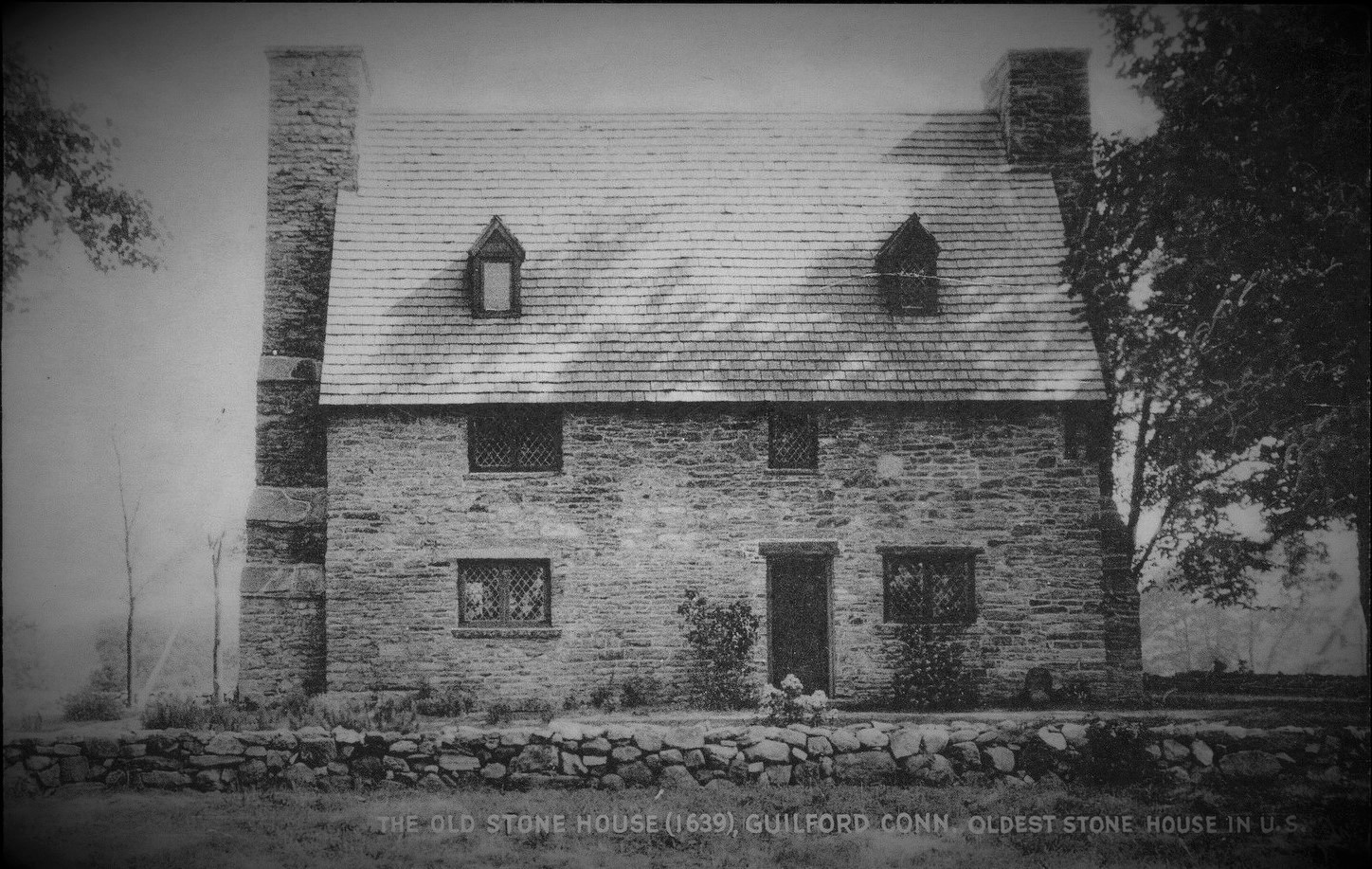
Early photo of the Henry Whitfield Old Stone House, Guilford, CT.
(Click photo to enlarge)
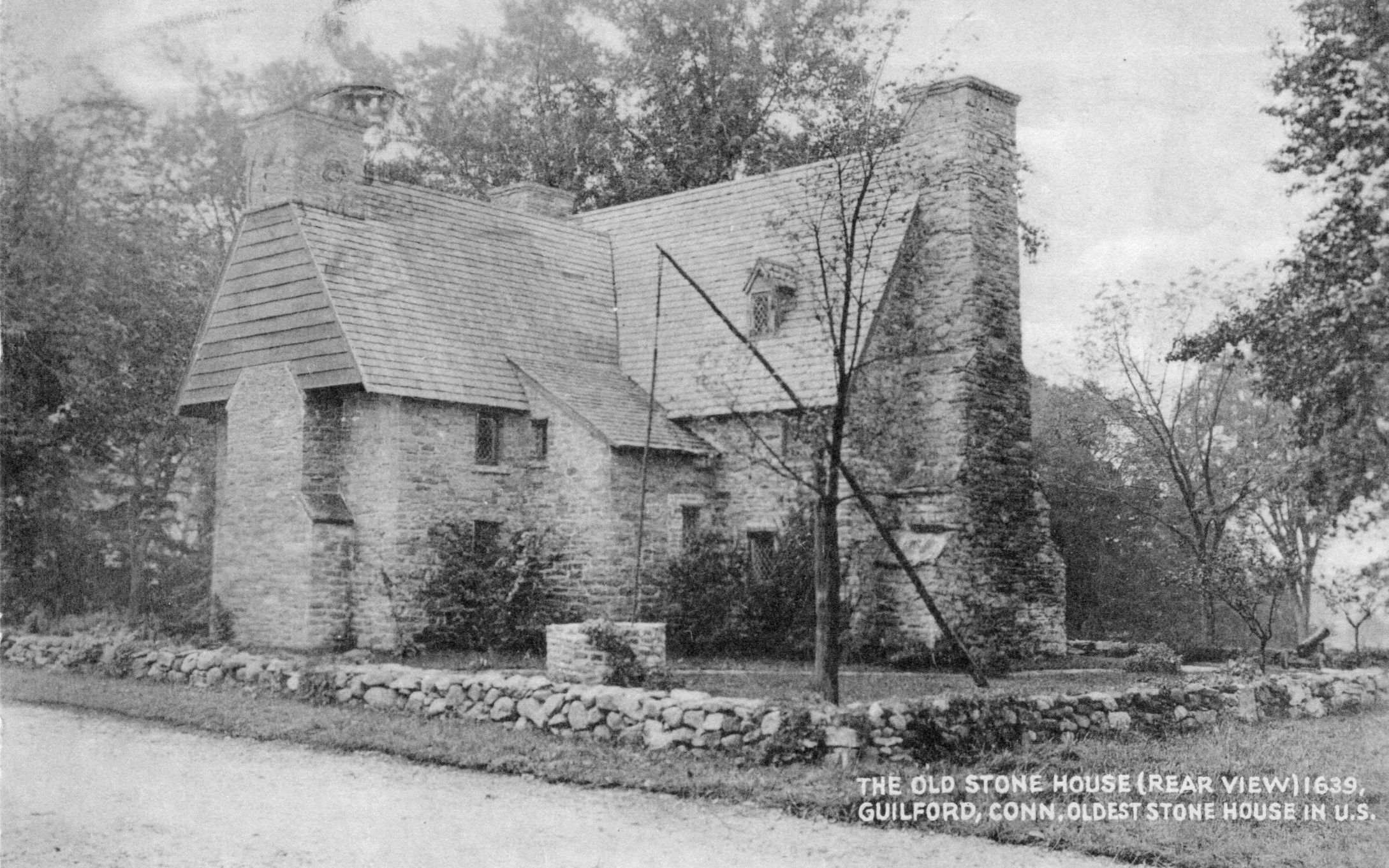
Early photo of the rear of the Henry Whitfield Old Stone House, Guilford, CT.
(Click photo to enlarge)
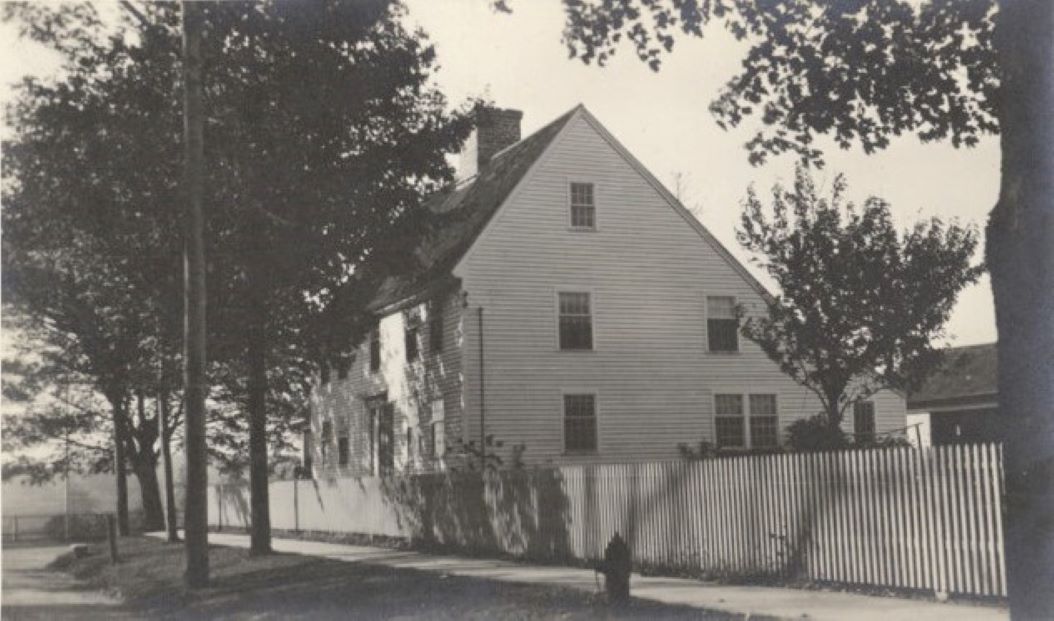
Regicides cellar site, Broad Street, Guilford, CT.
(Click photo to enlarge)
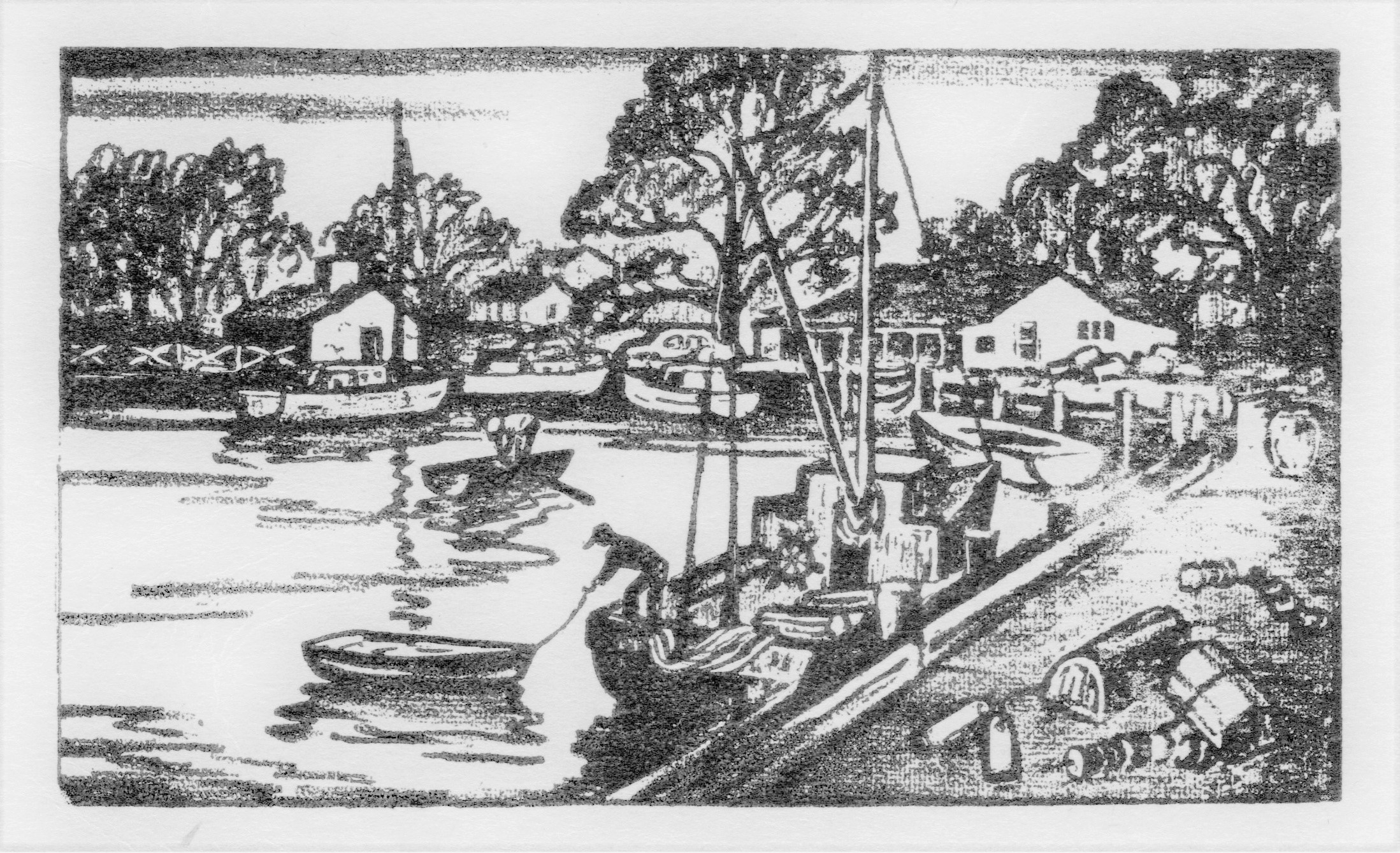
Early sketch of Guilford Dock with original Fish Market building on left.
(Click photo to enlarge)
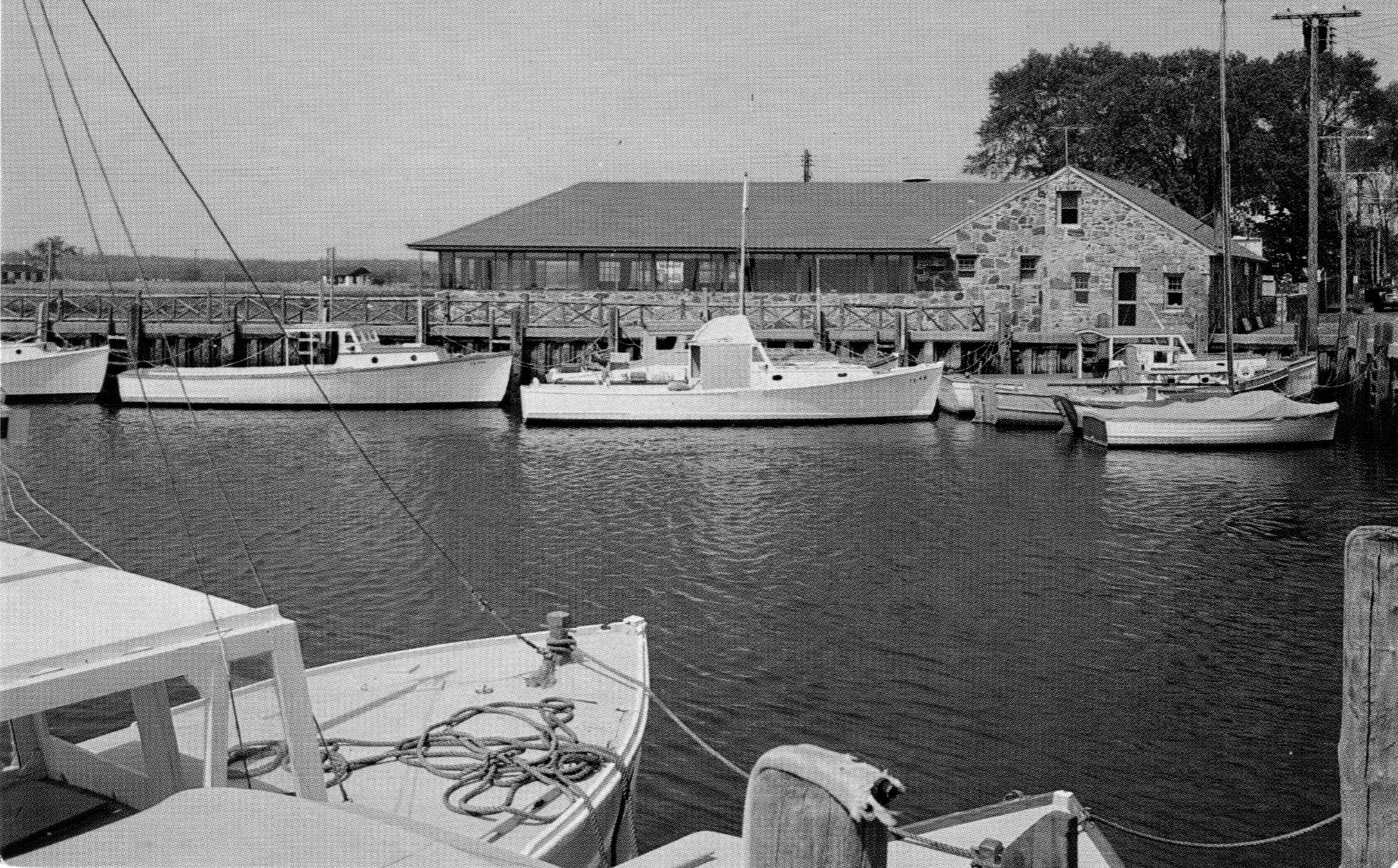
1950's photo of Guilford Dock with the Captains Table and Fish Market.
(Click photo to enlarge)
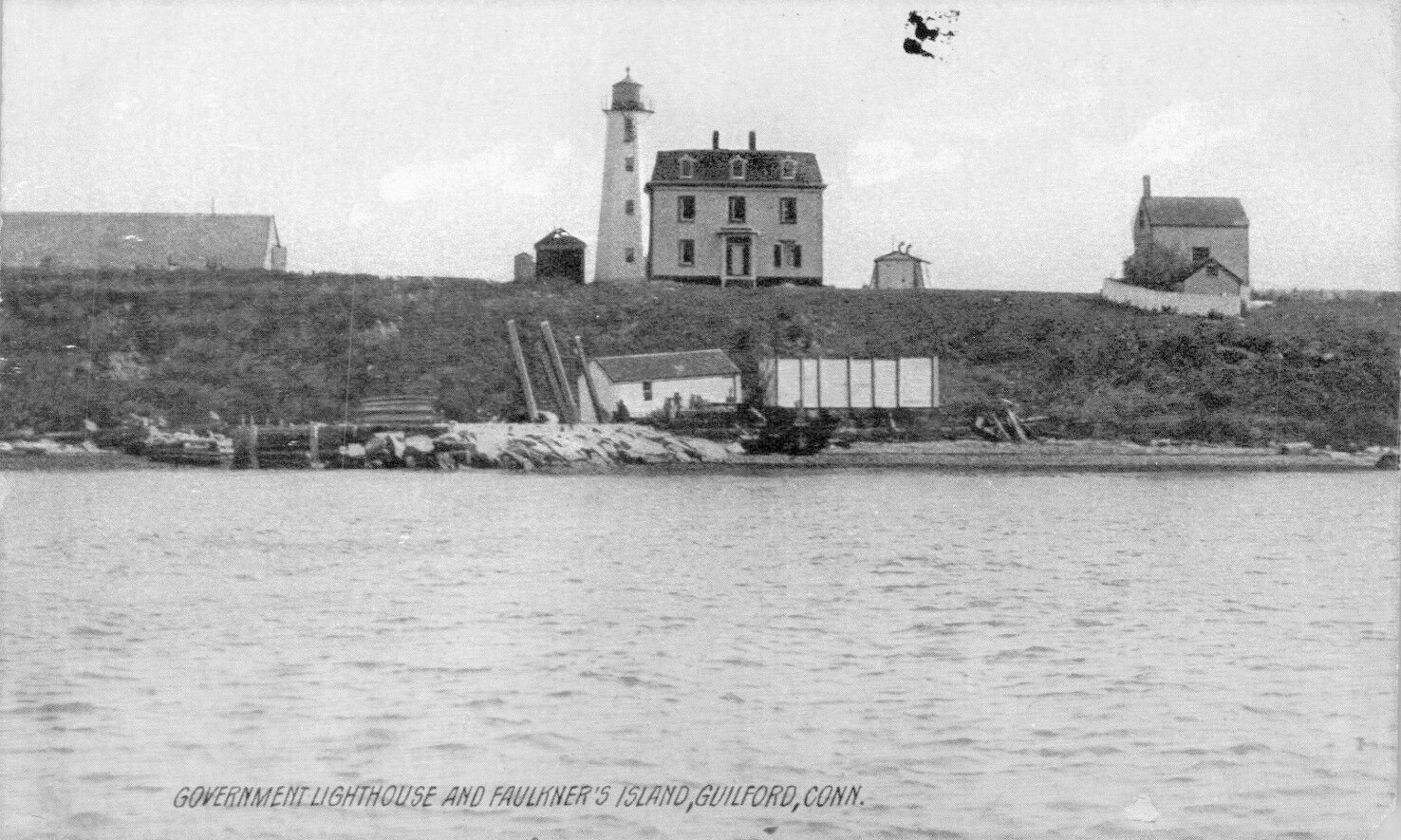
Early photo of Faulkners Island in Long Island Sound off Guilford. CT.
(Click photo to enlarge)
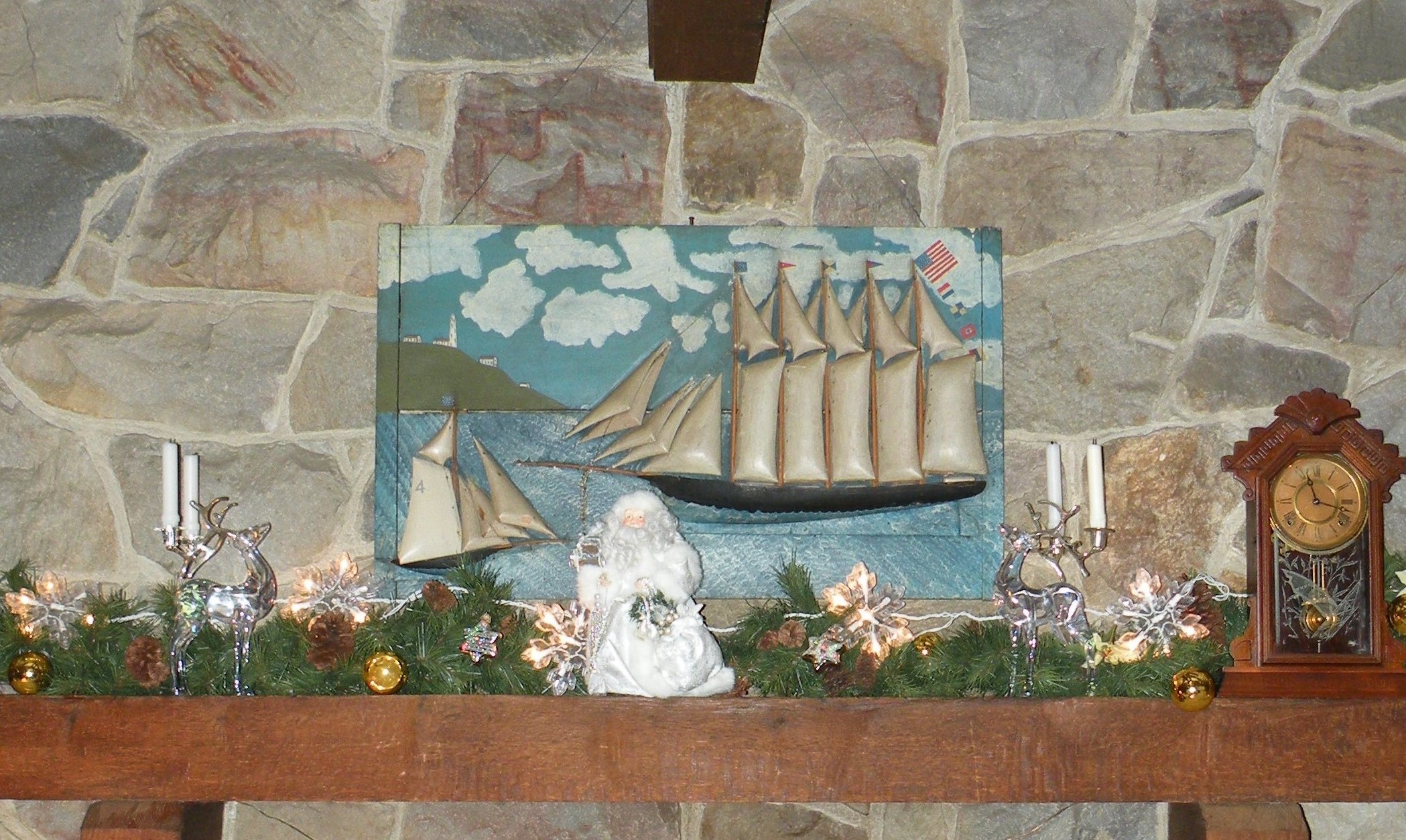
The Five Masted Half Model by Noah Ross hanging over a Christmas decorated mantle in the old farmhouse in Emmaus, PA.
(Click photo to enlarge)
Dr. Brian Owen
Emmaus, PA, USA
Top of Page